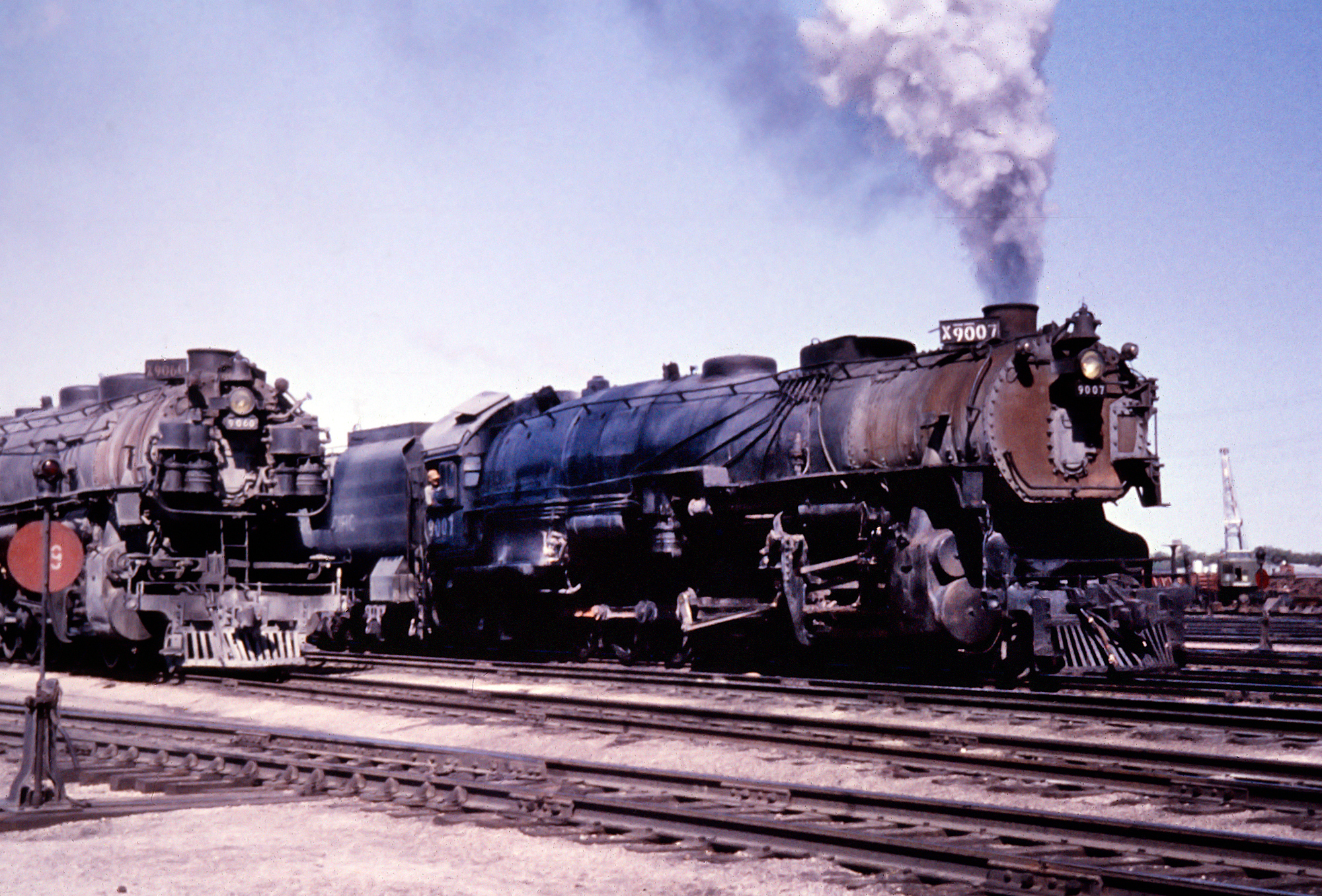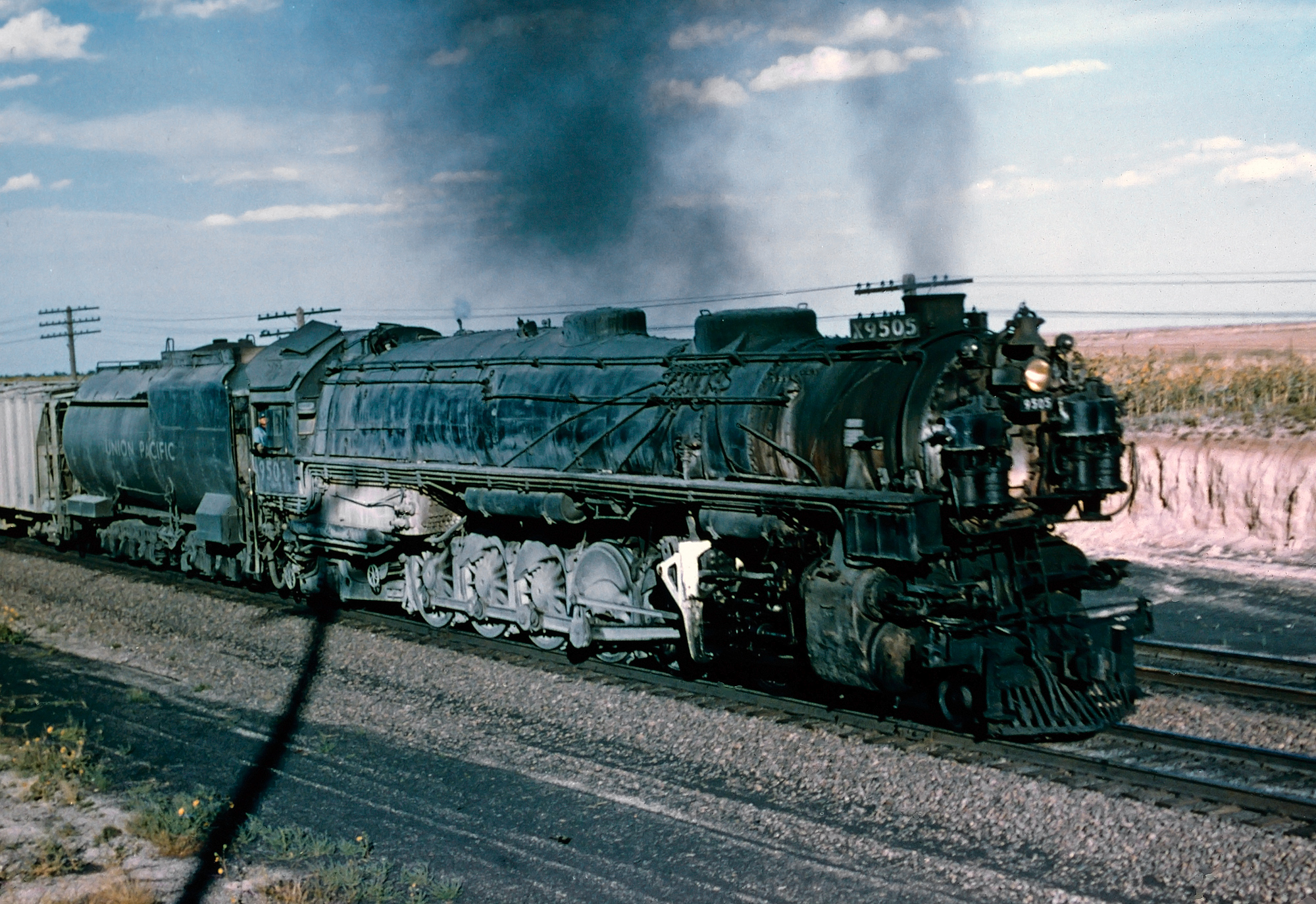Union Pacific 9000-series 4-12-2 on a tear through Lawrence, Kansas with a refrigerated boxcar train.

Union Pacific 9000-series 4-12-2 on a tear through Lawrence, Kansas with a refrigerated boxcar train.

Really, the UP 9000s had no reason to be as successful as they really were. As the only 12-coupled locomotives in the US, and a 3-cylinder design, they were a true freak of nature. At the time, the prevalent ten-coupled designs (2-10-0s and 2-10-2s) had proven to be unstable, rough-riding, abusive to infrastructure, slow, and often struggled to be worked at their full capacity for extended periods of time. Three-cylinder locomotives were almost universally disliked, usually offsetting any power gains by being more difficult to maintain and needing more frequent maintenance. Union Pacific had started with some 2-10-2s, then decided to add a third cylinder to create a 4-10-2, and so the next logical step was to add another drive axle and came up with a 4-12-2.
Alco built them with a dozen 67" drive wheels, which gave them a 30.66-foot driver wheelbase and a 52.33-foot engine wheelbase (compare that to a 63"-drivered UP 2-10-2 with a 22.50" driver wheelbase and a 41.42-foot engine wheelbase), 27"x32" outer cylinders with Walschaerts valve gear and 27"x31" inner cylinder actuated by Gresley conjugated-link valve gear. Particularly interesting was that the outer cylinders drove the third axle, while the inner cylinder drove the second axle. In an attempt to get them to navigate any sort of curves, the lead trucks were designed with more lateral motion than typical, and lateral motion devices were fitted to the front and rear drive axle. They also had a pretty massive 591 square foot firebox with 108 square feet of grate area.
While Union Pacific's main intent was for a 20-40mph freight locomotive that could reduce doubleheading, it was soon discovered that due to the more even power pulses from the three-cylinder configuration, the long rigid wheelbase, and the 67" drivers, they were incredibly stable at speed and could run smoothly at 60mph with a mile of cars behind them. UP ultimately ended up with 87 of these monstrosities and they were the ultimate in UP freight power until the arrival of the Challenger, which were a result of UP liking the 12-coupled power but wanting more flexibility. They still were a bit maintenance-heavy though, and running them at 60mph chewed up the Gresley conjugated-link valve gear, since it used friction bearings, causing the center cylinder to get out of time. Union Pacific fixed eight of them by instead adding a second Walschaerts valve gear on one side and actuating the center cylinder with a large rocker arm, but the rest were ultimately fixed with the addition of roller bearings on the Gresley valve gear.

When UP rebuilt eight of the 4-12-2s with the double Walschaerts valve gear on the engineer's side, they also moved the cross-compound air compressors off of the smokebox front and tucked one under each running board. The 8 locomotives, including #9007 shown here, were nicknamed "Bald-Faced Nines" after this modification. If you look closely, you can just make out the cylinder head caps for the center cylinder underneath the smokebox. Unlike the outer cylinders, where the piston valves are directly above the cylinders, the inner cylinders and pistons valves are laid on their side.

Bald-Faced Nine #9000 next to a later sister, the #9060. They are showing their years and neglect at this point.

Although originally all numbered in the 9000-9087 range, #9063-#9077 were transferred to UP subsidiary Oregon Short Line and renumbered to #9500-#9514. In 1928, eight of them were delivered as Oregon-Washington Railroad and Navigation Company #9700-#9707 and then became UP #9055–9062 when UP fully integrated OWR&NC. UP #9004 also became OWR&N #9708, and the reverted back to UP #9004.

Bald-Faced Nine #9011 at Topeka, Kansas. The lighting in this shot gives a better view of the inner cylinders, and if you look carefully you can see the double Walschaerts valve gear, with one link outside the drive rods in the conventional location, and one link inboard of the connecting rods.

In reply to NickD :
I'm having difficulty envisioning how the center cylinder could drive the 2nd axle without contacting the first axle?
Pete Gossett (Forum Supporter) said:In reply to NickD :
I'm having difficulty envisioning how the center cylinder could drive the 2nd axle without contacting the first axle?
It was mounted quite a bit higher than the other cylinders and angled 8 degrees above the horizontal to clear the first axle. It resulted in an uneven positioning of the intervals for the 3 cylinders. When looking at the locomotive from the right side, the intervals are as follows, rotating in a clockwise manner: 112 Degrees to the middle crankpin, then 128 Degrees to the left crankpin, then finally 120 degrees back to the right crankpin. This positioning gave the locomotive a very distinctive and uneven sounding exhaust that made it sound like each exhaust blast was trying to beat the next one out of the stack.

You can see just how much higher the center cylinder is over the outer cylinders. You can also see the rockers from the front of the outer piston valves to actuate the center piston valves. The conjugated link mechanism was developed by Sir Nigel Gresley, a British locomotive designer who was big on 3-cylinder locomotives and designed such machines as LNER #4468 Mallard, and was used by Alco under license.
RevRico said:Would any of you guys be interested in some old old railroad lanterns?
They're just in my way and I don't want to break them, but I don't really have anywhere to display them or do anything with them.
$20 + shipping for both of them. Not sure what size box they'll fit in, but I'll pack them as securely as I can.
In case I forget to check this thread for a while, shoot me a message. Esseeno (at) gmail
I would like the Dressel lantern, Rev. I'll shoot you a PM.
PM Sent.
On the subject of UP's big 9000s, Howard Fogg recorded one in 1954. The link will take you to an MP3 sound file of that recording. They really were a unique sounding locomotive, with an odd, syncopated exhaust pulse.
A squared-off lower edge to the smokebox was a giveaway that an engine was, or at least had been, a 3-cylinder locomotive. The bottom of the smokebox was flattened off to give more room to access the center piston.
New Haven R-3 class 3-cylinder 4-8-2. The 3-cylinder arrangement was not the Achilles Heel of these machines, it was the weird watertube boilers. Shortly after entering service, they were reboilered with conventional boilers and were much more successful.

DL&W 3-cylinder 4-8-2. These were less a dual-purpose Mountain and more a heavy Mikado with an extra lead axle to support the third cylinder. Due to being run in freight service and keeping the speeds lower, they were much less trouble than other 3-cylinder machines.

Southern Pacific's 4-10-2s, which resulted in a 4-10-2 being named a "Southern Pacific type". UP bought some of the exact same design and called them "Overland types". SP loved theirs but UP loathed theirs, saying they were too complicated and had too long of a rigid wheelbase. UP then turned around and bought the 4-12-2s, which used the same basic mechanical architecture with an even longer wheelbase and loved them, so I think it was more of an issue with them being either not of their own design or just being trailblazers.

Indiana Harbor Belt's monster 3-cylinder 0-8-0 "super switcher". It was a 3-cylinder switcher locomotive with an Elesco feedwater heater and a side-rod booster engine on the lead truck of the tender.

Insult upon insult, a UP FEF Northern, demoted from crack varnish like the Overland Limited and City Of Los Angeles, is now grungy, grimy, demoted to freight service, and has a Baldwin VO-1000 as a head-end helper on a livestock train.

Union Pacific FEF-2 Northern acts as a head-end helper to Big Boy #4006 as they start out of Cheyenne

Union Pacific FEF-3 Northern #839 hurries the livestock to market as it rounds a curve at Brady, Nebraska in September of '56. The UP Northerns were designed specifically for passenger usage to replace the old 7000-series Mountains and lived most of their lives in passenger service. But in the mid-to late-'50s, between the arrival of diesels to handle passenger service, and Challengers and Big Boys falling out of service for need of major repairs that UP didn't want to spend money on, the FEFs found themselves moved to the freight power pool, where they performed admirably.

UP #826 still in passenger service in '56. The consist is a far cry from the Overland Limited, Portland Rose, or City of streamliners though. Present in the mix of liveries is Pullman Green, UP two-tone grey, UP Armour Yellow and grey, and D&RGW yellow and silver. The baggage car also looks like it might be labled for Southern Pacific as well.

UP #838 is paired up with a set of E-units as it heads into Denver with the Portland Rose. The Rose was one of the last passenger trains into the Mile-High City still drawing a steam assignment in '57.

Recon1342 said:On the subject of UP's big 9000s, Howard Fogg recorded one in 1954. The link will take you to an MP3 sound file of that recording. They really were a unique sounding locomotive, with an odd, syncopated exhaust pulse.
It sounds like it's staggering home drunk.
You'll need to log in to post.